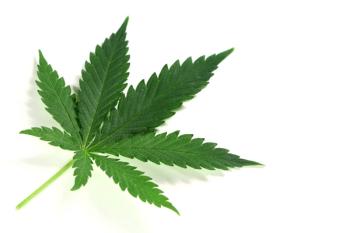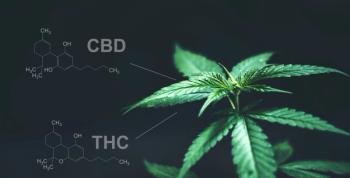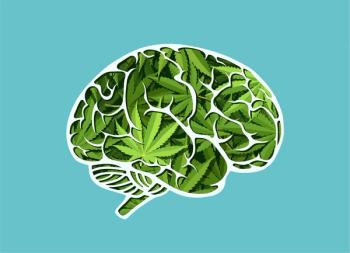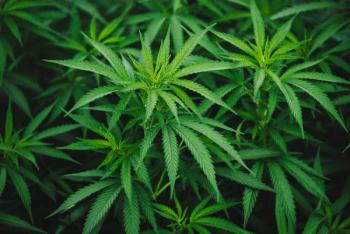
- December 2021
- Volume 2
- Issue 4
A Doctor’s Fight for Cannabis Reform and Regulation
Peter Grinspoon, MD, a primary care physician at Massachusetts General Hospital and an instructor in medicine at Harvard Medical School, shares his knowledge on medical cannabis, issues facing the industry, and hopes for the future.
Cannabis often suffers from its bad reputation as a pathway to get high and cause chaos. Peter Grinspoon, MD, a primary care physician at Massachusetts General Hospital and an instructor in medicine at Harvard Medical School, was raised with knowledge of both the good and bad sides of cannabis. Most people in the 1970s and 1980s only heard about the harms, however, Dr. Grinspoon was taught about the negative effects and the benefits, an approach not often used by people.
The medicinal benefits of cannabis were witnessed firsthand by Dr. Grinspoon through his brother, Danny, who had been diagnosed with childhood leukemia. Danny’s medical treatment included chemotherapy which was so hard on his body that it was preventing him from holding food down. Their parents obtained some cannabis illegally in the early 1970s and Danny’s experience with the plant was transformative. For the last year or so of his life suffering from the illness, he was able to eat and not get sick.
“When I went to medical school, I knew that cannabis was an effective medication for at least some things. Whereas they were still—and they still are in some medical schools—unfortunately, treating it like, you know, this dangerous drug of misuse that doesn’t have any medical application or benefits,” said Dr. Grinspoon.
Throughout his education the pros of the plant were not discussed. Instead, his education focused on watered down drug war ideology. “They didn’t teach us about the endocannabinoid system, the whole complex network of receptors and transmitters in our brain by which cannabis works and by which, like many of our systems work in our bodies. And I’ve always been really interested in that. I think it was really good for my education to understand the cannabis,” explained Dr. Grinspoon.
“While it certainly has some potential harms and dangers that we have to be aware of, and we have to use it safely and wisely at the same time, it has an incredible array of potential benefits. And I wish our medical education would reflect that. It’s still a casualty of the drug war, and I think that really needs to change,” he added.
Through his positive experiences with medical cannabis, Dr. Grinspoon knew that there was more than one side to cannabis. Once he obtained his medical degree, Dr. Grinspoon wanted to incorporate the medicinal opportunities of the plant into his practice as an option to his patients. One of the groups of patients he cares for are veterans. While veterans suffer from various ailments, Dr. Grinspoon often sees them come in with symptoms of post-traumatic stress disorder (PTSD). He shared that has seen medical cannabis help these patients with sleeping, anxiety, chronic pain, and PTSD.
Dr. Grinspoon is a strong advocate for medical cannabis. The Department of Veterans Affairs (VA) does not offer medical cannabis treatment to their patients because of cannabis’s Schedule I status. In Canada, Dr. Grinspoon explained that their government pays for medical cannabis so veteran patients don’t have to. Veterans are one of the many active groups advocating for cannabis and demanding more access for use and access to more research for the plant because they have witnessed first-hand of how it has helped them. The government takes a more intense approach of how they handle cannabis, clouded by the drug war ideology, and focused on proving how cannabis is bad or doesn’t work. Tens of millions of people successfully and productively use it for their symptoms. The use of medical cannabis by patients and research that has been completed have both shown the amazing benefits it can have on various ailments.
Dr. Grinspoon discussed the negative take the VA has on cannabis. “I work with veterans that use it for chronic pain. I work with veterans who have used it to get off of opiates for chronic pain. They’re now happily using cannabis instead of huge doses of oxycodone and benzodiazepines,” he said. “The VA has no problem doling out pills hand over fist. I mean, it seems like they’re doing a little bit less of that now. But they would be so much better off allowing their doctors to certify people for cannabis. Or at least, not penalizing the veterans for using cannabis. I mean, they lighten up a little bit every year. But just a few years ago, the doctors weren’t even allowed to mention cannabis.”
Another patient of Dr. Grinspoon’s is a veteran who transitioned from using six shots of vodka twice a day and never leaving his house, which affected his mental health because of the isolation and loneliness. Now, the patient takes a puff twice a day of cannabis with some cannabidiol (CBD) in it and is able to enjoy his life again. “He’s fishing with his buddies. He’s re-engaged in life. His life is so much better,” said Dr. Grinspoon. “I mean it really does not help everybody, but it does work for a certain segment of people with PTSD. It can be transformative. And given that cannabis is equally, or much less harmful than the other treatments for PTSD, the benefits outweigh the harm.”
If veterans say that this treatment option works for them, it should be made more available and without repercussions. Cannabis is a medicine with more pros than cons. You cannot overdose from using it and it’s a natural alternative. Dr. Grinspoon detailed how studies have shown that when people start using cannabis, they very often cut down their benzodiazepine use, valium, klonopin, and the use of other drugs like opiates. Cannabis helps other ailments beyond PTSD.
“As a primary care doctor, if you’re my patient and you have a symptom, I’ll try something. And if that doesn’t work, I’ll try something else. And if that doesn’t work, I’ll try something else. So the more options we have, the better,”
said Dr. Grinspoon
“Cannabis is an option that many people find really helpful. But again, people ask, is cannabis safe or not safe? I prefer to ask, is cannabis safer or as safe as anything else I’d be trying, and the answer is often yes. For insomnia, it’s much safer than the Ambien. Ambien is not a harmless drug by any means or the other sleeping pills that we use. The other sleeping pills are not without side effects. The more options we have to treat people, the better. And it’s just so arbitrary and ridiculous that we don’t have this safe, relatively nontoxic medicine,” he added.
Dr. Grinspoon did share that all medications can have some harms. “We have to be careful about plant-based medicine to give to people instead of giving them a big dose of Ambien. For example, I don’t mean to pick on Ambien, but just as an example, Ambien, you can drive in the middle of the night and not be aware that you’re doing it,” Dr. Grinspoon explained.
He believes that cannabis should be a more easily accessible medicine alternative. Through the nonprofit he works with, Doctors for Cannabis Regulation (DFCR), he hopes to do just that. DFCR is an organization made up of mostly doctors but doesn’t exclude others from joining. Group members believe that cannabis should be legalized and regulated. “We have a very specific platform of ideas, but the main idea is that the harm of criminalizing cannabis is much worse than the harm of having it be legal and just regulated so that, we’re not throwing people in prison to rot just for using a plant-based medicine,” said Dr. Grinspoon. “It’s a very bizarre paradox in this country that in parts of it, you could sell cannabis and become a prisoner and go to jail for 10 years. We’re really working on legalization, and we’re also working on really educating healthcare providers. Because, as I mentioned before, the healthcare providers, especially the doctors, really don’t know that much about cannabis. Many of them know next to nothing, and that’s not their fault. It’s because they haven’t been taught it. It’s a little bit their fault. Doctors, just haven’t been particularly curious about cannabis, and they haven’t really done their due diligence because you can be able to tell if this stuff you’re being taught is nonsense.”
When Dr. Grinspoon begins working with a veteran, the first step he takes is building trust and rapport. “Doctors have been so dismissive about cannabis that many patients don’t even mention it to their doctors. If the doctor is, I would say, particularly the psychiatrist. But in general, particularly the addiction doctors. But in general, if the doctors are like, you don’t use marijuana, do you? The patients would be like, Oh, no, no doctor. Of course, I don’t use marijuana. And then that’s the end of the discussion. I mean, I’ve written before that if you’re a physician regardless of your own personal feelings about cannabis—whether you’re pro, neutral, anti, couldn’t care less about it, huge advocate, whatever—you have to be open in your discussions with patients and non-judgemental, or find some way to not convey your judgement because otherwise patients just won’t bring it up. And it’s very dangerous not to have open communication with patients,” he explained.
When a person uses pharmaceuticals, they may experience a negative reaction or drug interactions. This is the same with cannabis. To be safe while using cannabis, communication on dosing and also outside factors come into play and help create a better outcome for patients. With his veteran patients, they are used to being dismissed, ignored, and penalized for bringing up cannabis with their physicians which is why Dr. Grinspoon likes to make his first step building trust and rapport. “And then, we just have the usual discussion, which is, what do you hope to get out of it? What are your experiences in the past? Did you have any bad side effects? I ask about any of the things that might give me concern, like, is there any family history of schizophrenia or psychosis? Because those are not absolute, but those are red flags that we have to be very careful about. Any history of addiction that we might want to be careful about. I also want to know what other drugs are they on. Then we want to discuss what their goals of treatment are and the different options. Do you want to inhale it? And then we talk about the safest way to do that, which is grinding up the flower and using a vaporizing machine so that you don’t harm your lungs or at least as much or a tincture under the tongue or an edible,” said Dr. Grinspoon.
"We also just talk about different types of cannabinoids that they could use, and then we try to come up with a way to get them on board that is very gentle and safe,”
he explained.
Aside from helping patients explore cannabis as a treatment option, Dr. Grinspoon spreads himself out in other ways to help others. He is certified as a health and wellness coach and is currently working on building a private practice for health and wellness coaching. He is also working on a book focusing on cannabis, the big picture, and his perspective. When he’s not seeing patients, he’s tackling how he can help people see the benefits of medical cannabis. One thing he hopes to see change in the medical cannabis industry is how edibles are labeled and not marked well. Dr. Grinspoon was shocked from what he was seeing when he visited a dispensary, “I don’t love the edibles that aren’t marked that well, that are very palatable to kids. I was at a dispensary this weekend and they had a chocolate bar that had 1100 milligrams of THC, which is an absolutely insane amount to put in a chocolate bar. And then you look at the wrapper and you need an electron microscope to see the word cannabis. It’s really not safe at all. So I asked about it and they’re said 'oh, it’s in individual pieces.' But that means each of the 10 chunks has 110 milligrams. Again, that’s an absolutely insane dose. Manufacturers have to find a way to make edibles safer because I’ve heard several stories of someone taking someone else’s chocolate accidentally and getting really sick,” he said. "At another dispensaries, they have a soda with 100 milligrams. Nobody drinks half a soda and 100 milligrams again is an insane dose for an edible. Maybe if you have a major injury and have to take a huge amount like you’re on the bell curve—the top 1%, you take 100 milligrams—but most people would take like 2.5, 5, or 10 milligrams. Why would you have a soda that has 100 milligrams in it in a medical dispensary?”
Although there is a lot of work needed to be done to help others gain better access to cannabis for medical conditions and also to prevent negative experiences such as those from poor labeling, cannabis is a growing industry and will continue to prove how beneficial it can be used as a medical treatment option over pharmaceuticals which carry many negative side effects.
For people looking to educate themselves more about cannabis, feel free to visit
To learn more about Doctors for Cannabis Regulations, you can visit
Articles in this issue
almost 4 years ago
December 2021 Digital Editionalmost 4 years ago
What Can We Do for Our Veterans?almost 4 years ago
PTSD by the Numbersalmost 4 years ago
Overview of the Research on Cannabis for PTSDalmost 4 years ago
Cannabis, Women Veterans, and VSOs: An Advocate’s Journeyalmost 4 years ago
Americans for Safe Access: Two Veterans Pushing for More Sciencealmost 4 years ago
Veterans Farming at CARE WaialuaNewsletter
Unlock the latest breakthroughs in cannabis science—subscribe now to get expert insights, research, and industry updates delivered to your inbox.




